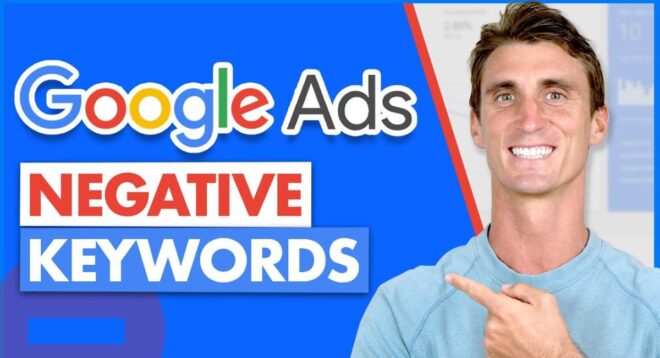
Negative keywords are terms and representations that you can add to your ad campaign that will help you restrict the visibility of your ads to individuals who are not likely to be curious about what you’re selling.

For instance, if you’re a plumber, you might like to count the keyword ‘plumbing’ as a negative keyword for your ad campaign, because you don’t want individuals who are looking for information about plumbing to see your ads. This will help make sure that your ads only show up for somebody who is actually nosy about what you’re selling.
Negative keywords are the keywords that you add to your campaign or ad group that help you exclude traffic that is not relevant to your products or services. This ensures that your ads only show up for searches that are relevant to what you’re selling. Adding negative keywords can help improve your click-through rate (CTR) and conversion rate since you’re only targeting users who are inquisitive about what you have to offer.
Negative keywords can be extremely helpful in streamlining your campaign and making sure that your ad money is well spent. Moreover, negative keywords are search terms that you don’t want your ad to show up for. You can add negative keywords at the ad group or campaign level adding them at the campaign.
What Do Negative Keywords Mean?
Adding negative keywords can help you save money on your advertising budget because it prevents your ad from appearing when people aren’t looking to buy what you’re selling. It’s also important to make sure that your ads are relevant to the keywords that you’re targeting because irrelevant ads can lead to lower click-through rates and lower conversion rates.
What Are Good Negative Keywords?
Negative keywords are mentions or expressions you’ll utilize to support and target your advertising to audiences who are additional doubtless to be inquisitive about what you’re merchandising. By together with negative keywords in your campaign, you can forestall your ads from showing once folks seek terms that aren’t involving what you’re selling.
Some smart negative keywords may well be “free”, “discount”, or “coupon”. you’ll additionally strive to target audiences who are already interested in what you’re selling by mistreatment keywords like “review” or “compare”. Experiment with completely different mixtures of negative and positive keywords to note which of them works best for your business.
Benefits of Using Negative Keywords
Negative keywords are words and phrases that you add to your Google Ads campaign to tell Google not to show your ad to somebody who is searching for those keywords.
There are a few different reasons why you might use negative keywords. One reason is to improve your ad’s quality score. Quality score is a metric used by Google (and other PPC platforms) to determine how relevant and useful your ad is. And one of the factors that go into the quality score is click-through rate (CTR).
There are a few benefits of using negative keywords:
- It can help you reduce your costs because you’re not paying for clicks from individuals who aren’t prying on what you’re selling.
- It can improve your click through rate (CTR) because it helps ensure that your ad is shown only to audiences who are interested in it.
- It can help you target your ads more effectively because you can be sure that they’re being shown only to audiences who are looking for what you’re selling.
Why You Should Be Using Negative Keywords?
There are several reasons why you might want to use negative keywords:
- To prevent your ad from showing up in response to unrelated searches (for instance, if you’re selling car parts, you might not want your ad to appear when someone searches for “flowers”)
- To reduce the amount of competition for your ads (by excluding high-traffic terms that have low conversion rates, you can improve the click-through rates and ROI of your campaigns.
What Are Positive and Negative Keywords?

Negative keywords are the keywords that you don’t want your ad to show up for. The opposite of a negative keyword is a positive keyword – these are the keywords that you want your ad to show up for. So, continuing with the example above, if somebody searches for “buy Widgets online”, that would be a good positive keyword for you to target.
How to Identify Negative Keywords
Negative keywords are basically the opposite of keywords. They’re the terms and words that you don’t want your ad to show up for. How you identify them depends on what kind of business you have, but there are a few general tips that can help.
First, take a look at your existing Google Ad campaigns and see which keywords aren’t performing well. These could be potential negative keywords. Also, look at your competitor’s ads and see what words they’re targeting. If they’re ranking higher than you for certain keywords, it might be because they’ve excluded negative keywords that you haven’t thought of.
You can also use Google’s Keyword Planner tool or some other keyword research tools to help you find negative keywords.
What Are Negative Keyword Match Types?
Negative keyword match types are keywords that you add to your campaign to tell Google not to show your ad to individuals who are looking for those things.

There are three types of negative keywords:
Exact match: Adding a phrase as a negative keyword, and the ad won’t show if someone searches for that phrase exactly.
Phrase match: Adding a word or phrase as a negative keyword, and the ad won’t show if someone searches for that word or phrase in any order.
Broad match: Adding a keyword as a negative keyword, and the ad won’t show if someone searches for that word or phrase, but also includes synonyms, similar words, and related terms.
How Do You Find Negative Keywords On A Website?
Negative keywords are words or phrases that you want to exclude from your search results. This can be helpful if you’re trying to target a specific audience and don’t want your ad to show up for searches that aren’t relevant to your business.
To find negative keywords on a website, you can operate the Google Keyword Planner tool. Just enter the website URL into the Google Ads interface and click on “Keywords.” Then, scroll down to the “Negative keywords” section and add any words or phrases that you don’t want your ad to show up for.
How to Add Negative Keywords
Negative keywords are excellent thanks to improving your Google Ads campaigns by making certain that your just ads aren’t shown to somebody who isn’t inquisitive about them. They’re words or phrases that you raise your campaign as some way of telling Google that terms you don’t want your ads to indicate up for.
To feature negative keywords, visit your campaigns and choose the Keywords tab. Then click on the pencil icon next to the ad cluster wherever you wish to add them and kind within the words or phrases you’d wish to use as negatives. Click Save and you’re done. You’ll conjointly add negative keywords at the account level, so they’ll be applied across all of your campaigns.
In conclusion, negative keywords are a crucial part of any paid search campaign. They permit you to fine-tune your campaigns and confirm that you’re not targeting the incorrect individuals together with your ads. During this article, we’ve shown you ways to seek out negative keywords, use them in your campaigns, and track them effectively.
We tend to hope you found this data useful which it’ll assist you to improve your paid search results. Have you ever tried exploiting negative keywords in your own campaigns? What tips does one have for our readers? Allow us to recognize this in the comments below.

